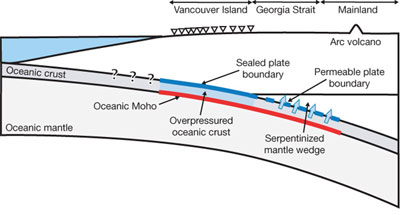Fluids in the fore arc of Cascadia:
Evidence from seismic imaging
By:
Pascal Audet
Miller Research Fellow
Seismological Laboratory
University of California Berkeley
| When: | Friday, October 222010, 10:30 a.m. to 11:30 a.m. Join us for coffee beginning at 10:00 a.m. |
| Where: | Seminar Conference Room, 10100 Burnet Road, Bldg 196-ROC, Austin, Texas 78758 |
| Host: | Sean Gulick, UTIG |

Abstract
10 years ago, intriguing observations in Cascadia and Japan have revealed that the deep extension of subduction thrust faults is periodically slipping and releasing large amounts of strain accompanied by low amplitude seismic rumbling, called "tremor". Remarkably, these events occur simultaneously without producing observable earthquakes of equivalent magnitude.
Such events, called Episodic Tremor and Slip (ETS), are one of the most exciting discoveries in the geosciences within the last 10 years, and offer new insights into subduction fault processes. To understand the origin of ETS events and their link with the earthquake cycle, it is crucial that we develop models of subduction zone structure in the vicinity of the tremor source. In this presentation I will describe seismological investigations that image the subducting oceanic crust beneath the North American plate in the Cascadia subduction zone.
These studies reveal that tremor occurs in a region characterized by extremely high pore-fluid pressures, which suggest that pore-water is trapped by low-permeability fault sealing. Combined with an inferred down-dip transition in the permeability of the plate interface, these results may indicate a link between the transport of water into the subduction zone and the transient, periodic behavior of ETS, with important consequences for earthquake hazard in Cascadia. Finally, I will explore opportunities for future work in Cascadia and beyond.




